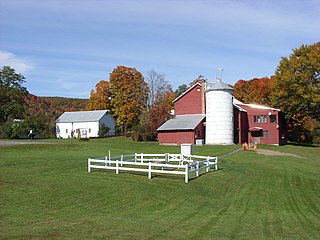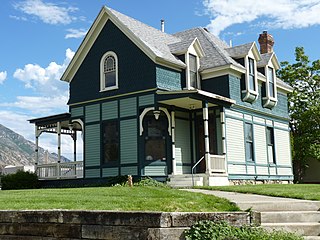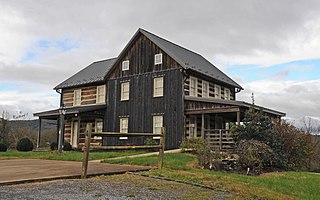
The Thomas Eakins House is a historic house at 1727-29 Mount Vernon Street in the Spring Garden section of Philadelphia, Pennsylvania, US. Built about 1854, it was for most of his life the home of Thomas Eakins (1844-1916), one of the most influential American artist of the late 19th century. It was designated a National Historic Landmark in 1965, and is now home to a local artist cooperative.

The Thomas and Mary Nimmo Moran House is a historic house museum at 229 Main Street in East Hampton, New York. Built in 1884, it was the home of Mary Nimmo Moran and Thomas Moran, both accomplished painters of the nineteenth century. The house was designated a National Historic Landmark in 1965 for its association with Thomas Moran, the first major painter to bring scenes of the American West to the rest of the country. The house has been restored and opened to the public by reservation under the care of the East Hampton Historical Society.

The Wentworth Lear Historic Houses are a pair of adjacent historic houses on the south waterfront in Portsmouth, New Hampshire. Both buildings and an 18th-century warehouse were owned by the Wentworth Lear Historic Houses and were operated as a house museum. Only the Wentworth-Gardner house is a museum. They are located at the corner of Mechanic and Gardner Streets. The two houses, built c. 1750–60, represent a study in contrast between high-style and vernacular Georgian styling. The Wentworth-Gardner House is a National Historic Landmark, and the houses are listed as the Wentworth-Gardner and Tobias Lear Houses on the National Register of Historic Places.

The Lansing Manor House is a historic home located in North Blenheim, Schoharie County, New York, United States, adjacent to the Blenheim-Gilboa Visitors Center and Mine Kill State Park. It was built in 1819 by John Lansing Jr. for his daughter and son-in-law, Jacob Livingston Sutherland. John Lansing Jr. represented New York as a delegate to the Constitutional Convention in 1787, and the state's Ratification Convention in 1788.

Harris Farm is a historic home and farm complex located at Walkersville, Frederick County, Maryland, United States. The main house was built in 1855, and is a three-story center plan house in predominantly late Greek Revival syle, with some Italianate elements. The agricultural complex consists of a bank barn with an attached granary; a second frame barn that shares an animal yard with the bank barn; a row of frame outbuildings including a converted garage, a workshop, and a chicken house. There is also a drive-through double corn crib; and a frame pig pen from 1914. The 20th-century buildings consist of a frame poultry house, a dairy barn with milk house and two silos, and an octagonal chicken coop. A lime kiln is located on the edge of the property. The property is preserved as part of the Walkersville Heritage Farm Park.

The John M. Winstead Houses, also known as Pleasant Hill, are three antebellum houses in Brentwood, Tennessee that were together listed on the National Register of Historic Places in 1988.

The William D. Alexander House is a historic house located in Provo, Utah. It is listed on the National Register of Historic Places. It is asserted to be the only period example of Stick Style architecture in the state of Utah.

Rock Hill Farm, also known as the Davis-Stauffer Farm Complex, is an historic, American home and farm and national historic district located in Montgomery Township in Franklin County, Pennsylvania.
George Arnold House was a historic home and farm complex located at Kenton, Kent County, Delaware. The house was built the 1830s, and was a two-story, three-bay, side-plan dwelling with a rear wing in the Greek Revival style. Contributing outbuildings included frame chicken houses, sheds and corn cribs, milk house, and a bank barn. They dated to the late-19th and early-20th centuries.

Thomas Attix House is a historic home and farm complex located at Kenton, Kent County, Delaware. The house was built in about 1880, and is a two-story, three-bay, frame dwelling with a rear wing in a Gothic Revival / Queen Anne style. Contributing outbuildings include a brick milk house, sawn-plank bull pen, frame barn, cattle sheds, and machine shed. They date to the 19th and early-20th centuries.

Alfred L. Hudson House is a historic home and farm located at Kenton, Kent County, Delaware. The house dates to about 1880, and is a two-story, five bay, center hall plan frame dwelling in a blended Queen Anne / Gothic Revival style. It has a cross gable roof and a bracketed heavy roof cornice. Also on the property are a contributing large gambrel-roofed barn, 2+1⁄2-story granary, chicken house, a milk house, machine shed and garage.
Thomas Lamb Farm, also known as "Brick House Farm", is a historic home located at Kenton, Kent County, Delaware. The house dates to the second quarter of the 18th-century, and is a two-story, three-bay, single pile brick dwelling. It has a hall-and-parlor plan. Attached is a 1+1⁄2-story, three-bay brick kitchen wing with a porch.

Jefferson Lewis House is a historic home located at Kenton, Kent County, Delaware. The house was built about 1800, and is a two-story, three-bay, center hall plan stuccoed brick dwelling with a gable roof. Attached is a rear frame wing. The front facade features a porch, added in the late-19th century. Also on the property are three two-story barns, and a mix of late-19th and early-20th-century milk houses, corn cribs, machine sheds and chicken houses.

White Hall, also known as the William Cann Tenant House and Andrew Elliason Tenant House, is a historic home located at Bear, New Castle County, Delaware. It was built in three phases during the 19th century between about 1830 and 1860, and is a two-story, five-bay frame dwelling with a gable roof. It has a 2+1⁄2-story rear wing that creates a "T" configuration. It is in a vernacular Greek Revival / Italianate-style. Also on the property are a contributing frame dairy barn, a concrete block milk house, and a frame implement shed, all dated to the 1930s.

Comdr. Thomas MacDonough House, also known as The Trap, is a historic home located near Odessa, New Castle County, Delaware. It was built in several sections. The two main sections are two stories and consists of a three bay brick section dated to the mid-18th century and a three bay frame section built between 1820 and 1830. Later-19th century additions to the house include frame one-and 1+1⁄2-story wings to the south gable end wall and southwest rear wall. Also on the property is a contributing farm building complex, including a shed, root cellar, and privy. It was the home of Commander Thomas MacDonough (1783-1825), an early-19th-century American naval officer noted for his roles in the First Barbary War and the War of 1812.

The T. H. Cabot Cottage is a historic summer house off Snow Hill Road in Dublin, New Hampshire. The cottage is one several buildings that was built by geologist Raphael Pumpelly on his summer estate "Pompilia". Built in 1899 after his daughter's marriage to Thomas Handasyd Cabot, it is a good example of Georgian Revival architecture. The house was listed on the National Register of Historic Places in 1983.

D. D. D. Barr House is a historic home located near Batesburg-Leesville, Lexington County, South Carolina. It was built about 1883, and is a one-story, frame, weatherboarded dwelling. The main core of the house has a hipped roof covered with metal shingles. A hip-roofed porch shelters three bays of the five-bay façade. Outbuildings include a 20th-century milk house.

The Woodman Road Historic District of South Hampton, New Hampshire, is a small rural residential historic district consisting of two houses on either side of Woodman Road, a short way north of the state line between New Hampshire and Massachusetts. The Cornwell House, on the west side of the road, is a Greek Revival wood-frame house built c. 1850. Nearly opposite stands the c. 1830 Verge or Woodman House, which is known to have been used as a meeting place for a congregation of Free Will Baptists between 1830 and 1849.
Knox Farm Historic District is a historic farm complex and national historic district located near Cleveland, Rowan County, North Carolina. The Robert Knox House was built between 1854 and 1856, and is a two-story, single-pile, three-bay vernacular Greek Revival style frame dwelling. It has a two-story rear ell, one-story rear kitchen ell. Its builder James Graham also built the Jacob Barber House and the Hall Family House. Other contributing resources are the log corn crib, reaper shed, power plan, chicken house, brooder house, log smokehouse, barn, main barn (1916), milking parlor (1948), spring house, tenant house (1920), and Knox Chapel Methodist Church (1870s).
Thomas–Wiley–Johnson Farmstead is a historic home and farm located near Johnsonville, Rensselaer County, New York. The farmhouse was built between about 1790 and 1800, and consists of a two-story, five bay, Greek Revival style frame main block with a kitchen wing added about 1840. It was remodeled about 1870, and has another wing added about the same time. Also on the property are the contributing main barn group with cow barn and milk house additions, hen house and corn crib, work shop, and garage.




















